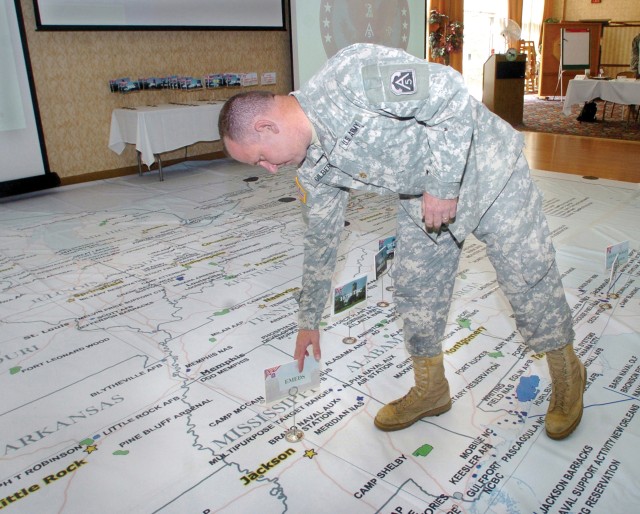
FORT BELVOIR, Va. (Army News Service, April 15, 2008) - Officials from 43 government agencies gathered around a detailed map here April 10 for a Rehearsal of Concept drill on hurricane relief operations.
U.S. Army North hosted the two-day event, which saw the various agencies go through the steps of readying assistance in the event of a major hurricane hitting North Carolina or Virginia.
According to U.S. Army officials, the ROC drill was held to ensure policies and procedures are sufficient to set the framework for the Army's response and readiness for the 2008 hurricane season.
Officials from agencies such as the Department of the Army, ARNORTH, the Army National Guard, the Federal Emergency Management Agency and the U.S. Army Corps of Engineers were present to summarize some of the procedures discussed throughout the day.
Brig. Gen. Fran Mahon, deputy commanding general, ARNORTH, noted the importance of rehearsing the different scenarios that may be encountered during a natural disaster.
"The drill we are doing here allows us to do gap analysis so we can look at each state's capabilities and plans," Mahon said. "This allows us to devise pre-scripted mission assignments for a crisis or when a storm hits."
Brig. Gen. Leodis Jennings, the Army National Guard's operations officer, outlined the process of hurricane preparation.
"The first response in the case of a crisis is from local officials," Jennings said. "If they determine they need assistance, then they request it from the state and, from there, the governor decides whether or not to call federal agencies in to help.
"If we're called for assistance, we'll begin strategically positioning assets for support," Jennings said.
Jennings also noted that the Army National Guard is always prepared to mobilize assets to support civil officials.
Holmes Walters of the U.S. Army Corps of Engineers said his agency is responsible for providing support to shore up the infrastructure in the event of a natural disaster.
"Under the national response framework, the USACE is responsible for public works and engineering," Walters said. "We are in charge of supplying contracting, real estate support, construction management and technical assistance to the affected area.
"We also provide temporary emergency power generation and install, maintain and operate them," Walters added.
Tom Davies, senior federal coordinating official from FEMA Region III, noted that FEMA has become a much more aggressive agency in light of the aftermath of Katrina. The federal government has invested money and manpower into making a much stronger agency.
"FEMA is not going to fail again," Davies said. "We'll do whatever we need to do to support the state."
Jennings closed by noting that emergency response is a team effort.
"We're all about taking care of the citizens of this country," he said.
(Sharbel is a staff writer for the Belvoir Eagle.)

Social Sharing